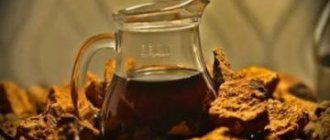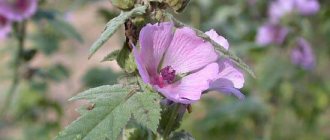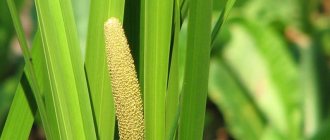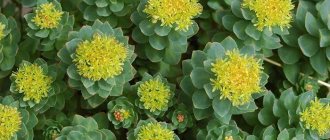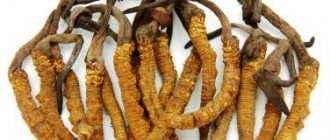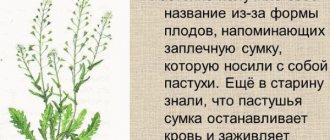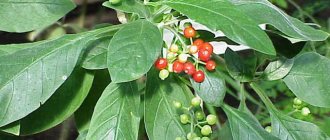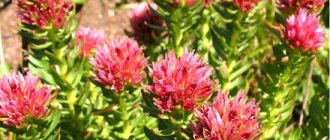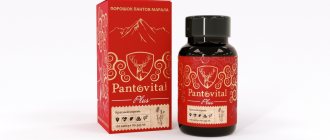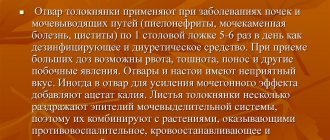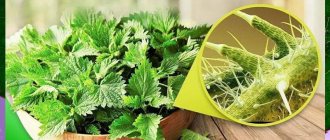The herbaceous perennial from the Madder family has several popular names - marina, marzana, crapp (krapp), petiolate madder or Georgian madder. Its Latin name (Rubia tinctorum) comes from the words rubber, which translates as “red”, and tinctorus – “dyeing”.
Madder root is considered a natural dye, which was used in the textile industry until the end of the 19th century. Today this plant is valued for its healing properties. You will learn about the medicinal properties and contraindications of the red root from this material.
What does madder look like?
Externally, the plant resembles St. John's wort: small flowers, elongated dense leaves curled into a ring around the stem, sharp small thorns. The stem of madder is thin, covered with rough bark. It can reach a height of one and a half meters.
The leaves are wide and dense, covered along the edges with sharp bristles. Madder blooms with small greenish-yellow flowers that resemble St. John's wort inflorescences. The powerful root system consists of the main root and numerous thin roots covered with brown bark.
Advantages and disadvantages
As follows from the reviews of patients who took madder extract, the product is really effective and helps greatly against stones in the kidneys and urinary tract. The drug perfectly loosens stones, removes their debris and sand from the body, reduces spasms during renal colic, reduces pain, and improves overall well-being. Many note that the drug is effective in veterinary medicine. They can treat diseases of the ureteral system in cats.
As a disadvantage, many note the need to take such a remedy three times a day, the duration of the course, and its further repetitions. In addition, patients claim that the tablets dissolve slowly in water and have a tart and even bitter taste.
Madder root
This herb was first used in the textile industry. Dyes from madder root made it possible to dye various natural fabrics - silk, cotton, wool. Now the plant is used in folk and traditional medicine.
Traditional healers use this medicinal herb to prepare tinctures, decoctions and powders that provide relief from many serious diseases. In traditional medicine, the complex drug “Cystenal” has become widespread. The drops contain: extract from madder rhizome, magnesium salicylate, ethyl alcohol, eucalyptus, anise, phenicyl essential oils, olive and castor oil.
This medicine is prescribed for spasms and inflammation of the urinary canals, and urolithiasis. Take Cystenal five drops half an hour before meals. After conducting the necessary examinations and consulting with a doctor, a specialist may increase the dosage or extend the course of treatment. Taking drops during meals reduces acidity. Treatment lasts a month.
Contraindications to the use of madder and side effects
Indications and contraindications for madder dye are closely related to each other. It is prohibited to use decoctions and infusions of roots:
- with glomerulonephritis;
- for gastric ulcers and acute pancreatitis;
- during pregnancy;
- during breastfeeding;
- in case of individual allergy to the plant.
When using medications, it is important to follow prescription dosages. If safe volumes are exceeded, madder can excessively increase renal peristalsis and provoke sudden movement of stones. This will lead to painful colic and bleeding. Also, madder root should not be used for too long without interruption. It contains lucidin, which can provoke cancer when accumulated in the body.
Chemical composition
The medicinal properties of madder roots are due to their rich chemical composition. They contain:
- tartaric, citric, malic organic acids;
- flavonoids;
- coumarins;
- ascorbic acid;
- anthraquinones;
- pectins;
- sugar;
- iridoids;
- B vitamins;
- essential oils containing phenols;
- proteins;
- tannins;
- carbohydrates;
- iron;
- potassium;
- natural dye;
- magnesium.
Analogs
An excellent solution for replacing madder dye is Canephron, Blemaren, Urolesan, Urocholesan and others. These drugs can have a similar effect, but differ in their composition. For this reason, their use should only be prescribed by an experienced specialist.
Many doctors recommend Cystenal. This is a medication based on madder root, magnesium salicylate, essential oils, ethyl alcohol, and olive oil.
Take two to three drops per piece of sugar, thirty minutes before meals. If the attacks of colic intensify, then the dosage is reduced. In cases where heartburn from the medicine is noted, its administration is postponed to the time of eating or its end.
Medicinal properties
Madder herb has powerful nephrolytic properties. The substances contained in this plant have a destructive effect on kidney stones and promote their elimination. Medicines made from the root of the plant relieve pain and spasms, normalize water-salt balance, and loosen phosphates and oxalates.
Traditional healers successfully cleanse the body of waste and toxins with herbs. Once in the stomach, madder preparations stimulate the production of gastric juice, have an anti-inflammatory effect, enhance the excretion of bile, and cleanse the body of toxins and waste.
In addition, this medicinal plant cleanses the blood, improves immunity and promotes cell renewal. Coumarins contained in the herb destroy malignant cells, preventing the appearance of tumors. Juice obtained from madder root is effective for rickets and abdominal pain. Decoctions and tinctures of madder remove excess salt from the body, helping in the fight against osteochondrosis and joint diseases. By supplementing the root with other ingredients, you can heal wounds and bruises and clear the skin of rashes.
Helpful information
Madder dye is also successfully used in cosmetology:
- Anti-inflammatory properties help get rid of acne, cleanse the skin, relieve inflammation, and remove redness from sunburn. A lotion made from crushed momordica leaves will help remove inflammation and redness after mosquito bites.
- Whitening properties help lighten freckles, age spots, and even out skin tone.
- Toning properties will help rejuvenate the skin, restore its elasticity, and increase tone.
- To ensure that the skin of the whole body remains young and silky, it is recommended to take baths with decoctions.
You don't have to buy herbal tea for masks. It is enough to buy tablets with herbal extract and crush them in a mortar to a powder. It is better to use oatmeal or rye flour as a base for masks. For hair:
- Madder powder is mixed with henna and used to color hair. Depending on the ratio of dyes and the original hair color, you can get beautiful cool brown shades with a reddish tint. This coloring will not only change the shade of your hair, but also strengthen the hair follicles, making your hair manageable and shiny.
- A mixture of madder powder with ginger powder, white henna, lemon juice, hibiscus decoction or oak bark can be applied as a mask only to the hair roots.
On cat lovers' forums there is a lot of information on treating furry pets with drugs intended for humans. The instructions for using madder tablets to treat cats for urolithiasis are simple: take ¼ tablet, crush into powder and dilute in 25 ml of warm water.
Give at the rate of 1 ml per 1 kg of pet’s weight, in especially severe cases, increase the dosage by 2 times. It is best to give your cat water from a syringe without a needle. The course of treatment and dose must be agreed with your veterinarian.
Uses of madder
The medicinal properties and contraindications of the red root largely depend on the chosen dosage form. It has already been said that traditional healers prepare decoctions, tinctures, herbal teas and infusions from madder. Pharmacies offer to buy madder extract, which can be in the form of drops, powder or tablets.
In different forms, madder herb has different rules of use. More often in medicine, it is not the above-ground part of the plant that is used, but the root, the use of which differs from the greenery of the plant.
How to collect
The medicinal properties of madder are contained in the entire root system. Harvesting should begin in early spring - from March to early April.
Another harvesting option is from the beginning of August until the first cold weather. The roots are dug out using a shovel. Then they are shaken off the ground and the stems are cut off. Dry the roots in the shade or in a dryer at 45 degrees. The dried root can be stored for 2 years.
In order not to deplete the supply of growing madder, the next harvest should be carried out after 3 years.
The demand for the root of the plant is very high - due to its chemical composition, it is widely used in folk recipes and pharmacology.
How to take medications
Madder drops are used to remove calcium oxalates. They cause kidney stones. In accordance with the instructions, 20 drops of the drug are diluted in a glass of water. Take the medication before meals twice a day for a month.
Tablets from madder root should be taken 2-3 pieces, having first dissolved them in a glass of warm water. Treatment lasts from 20 days to a month, depending on the doctor’s recommendations.
Judging by people's reviews, after treatment with madder, if a person neglects contraindications, his chronic diseases may worsen. Before starting treatment, you must consult with a specialist and strictly follow the instructions for use of the drugs.
How to use
The use of madder in medicine is varied, due to the many beneficial properties of the plant. Madder is mainly taken to improve digestion and treat diseases of the urinary system.
Madder can be purchased at the pharmacy
The use of madder extract in pharmacology ensures the production of medicines of various forms and concentrations. They should be used strictly according to the instructions and after consultation with a doctor:
- Madder drops are used to remove calcium oxalates, which cause the formation of kidney stones. According to the instructions, 20 drops of the drug should be diluted in a glass of warm water. Take the medicine twice a day before meals. The course of treatment is 1 month.
- Madder tablets should be taken 2-3 pieces, after dissolving them in a glass of warm water. The course of treatment is from 20 days to 1 month.
- Madder root tincture is the basis for the drug “Cystenal”, which also contains essential oils, ethanol and magnesium. This drug is prescribed for inflammation of the urinary canals, spasms and urolithiasis. According to the instructions, you need to take Cystenal half an hour before meals, 5 drops three times a day. After consulting with a doctor and conducting the necessary examinations, the specialist may increase the dose or extend the course of treatment. Taking drops with meals will help reduce the acidity of gastric juice. The course of treatment is about 4 weeks.
We recommend reading: Celery - benefits and harms for the health of women and men, properties and contraindications
Overdose and neglect of contraindications can cause exacerbation of diseases. Before treatment, consult a specialist and strictly follow the instructions for using madder.
Powder for kidney stones
For urolithiasis, madder root dissolves the formed stones, promotes their removal, and stops the accumulation of harmful salts and phosphates in the ducts.
Ingredients:
- Madder root powder - 1 g.
- Water - 100 ml.
How to prepare : Dissolve the powder in warm water.
How to use : Drink the resulting medicine 3 times a day before meals.
Result : The stones are gradually destroyed under the influence of the medicine and removed from the body.
During treatment for urolithiasis, it is necessary to undergo a medical examination. Products high in oxalic and citric acid are excluded from the patient’s diet, and vitamin complexes are prescribed.
Infusion for cystitis
Due to its bactericidal and anti-inflammatory effects, madder infusion is used for cystitis.
Ingredients:
- Madder root - 15 g.
- Water - 400 ml.
How to prepare : Grind a small fresh madder root. Fill it with a glass of cold water and leave for 8 hours. Strain the infused mixture, and refill the crushed madder with 200 ml of boiling water. Strain the second part of the infusion after 15 minutes. Mix both extracts from the plant.
How to use : Divide the infusion into two doses and drink throughout the day.
Result : The medicine relieves inflammation, pain and discomfort.
Decoction for gout
A decoction prepared from madder helps remove salt deposits in case of gout, improves metabolism, which helps treat joints.
Ingredients:
- Madder root powder - 1 tsp.
- Water - 300 ml.
How to prepare : Pour boiling water over madder powder. Place the mixture on low heat and bring to a boil. Cook for 10 minutes. Cool and strain the broth.
How to use : Drink 100 ml of decoction 40 minutes after meals three times a day.
Result : Joint pain decreases, motor activity increases.
Infusion for prostatitis
The inflammatory process in the prostate gland can be relieved with the help of a herbal mixture, in which each ingredient has a therapeutic effect.
Ingredients:
- Dried madder root - 1 tsp.
- Rose hips - 1 tsp.
- Calendula flowers - 1 tsp.
- Wintergreen - 1 tsp.
- Shepherd's purse - 1 tsp.
- Angelica - 1 tsp.
- Water - 300 ml.
How to prepare : Mix equal amounts of herbs. Then 1 tbsp. l. Pour boiling water over the herbal mixture and leave for 2 hours. Strain the resulting product.
How to use : Divide the infusion into three doses before meals. The course lasts 10 weeks.
Result : Elimination of inflammatory processes and reduction of pain.
In order not to cause side effects, the preparation of the medicine requires full adherence to the recipe.
Application in veterinary medicine
Diseases of internal organs in pets also often occur due to metabolic disorders. Medicines containing madder will stop the progression of pathologies of the urinary system.
We recommend reading: Eyebright - medicinal properties and contraindications for use
Madder dyeing for cats and dogs
Pets suffer from kidney and bladder stones, just like humans. Madder will help remove stones from the body.
Ingredients:
- Madder tablets - 1 pc.
- Boiled water - 1 tbsp. l.
How to prepare : Divide the tablet into 4 parts. Grind a quarter of the tablet and dissolve in water. Put the resulting medicine into a syringe without a needle.
How to use : Observing the proportion - 1 ml of medicine per 1 kg of animal, give your pet water twice a day before meals.
Result : Breakdown of stones and their removal from the body.
If the disease is in an advanced state, the dose is increased. Before using the product, your pet should be examined by a veterinarian.
Powder for kidney stones
Madder root for urolithiasis dissolves stones, promotes their painless removal, and reduces the accumulation of harmful phosphates and salts in the ducts. To prepare the medicine, you need to dilute 1 gram of plant root powder in 100 ml of water. Take the resulting product three times a day before meals.
When treating urolithiasis, you should undergo a full medical examination. Products that contain citric and oxalic acid are excluded from the patient's diet. Vitamin complexes must be prescribed.
What to remember
- the plant contains toxic elements that are hazardous to health;
- strictly follow the recipe - harmful substances in case of overdose can cause poisoning;
- do not abuse the techniques - take the recommended amount of the product at a certain time;
- do not combine drug therapy or traditional treatment - leave intervals between the use of the compositions;
- the plant contains a large amount of microelements, acids and vitamins;
- the use of medications has a positive effect on the body and helps fight many diseases (urolithiasis, inflammation of the kidneys and bile ducts).
Other useful and medicinal plants
Creeping wheatgrass - medicinal properties, recipes, contraindications
Siberian fir - description, application, properties
Stevia (sugar substitute) - benefits and harms, reviews
Description of herbaceous elderberry, medicinal properties and contraindications
Treatment of cystitis
Due to the anti-inflammatory and bactericidal properties of madder root, the infusion is used for cystitis. To prepare it, fresh root of a small plant is poured with a glass of cold purified water, then infused for eight hours. The infused mixture is filtered, and the crushed root is poured again with 200 ml of boiling water. Strain the second part of the infusion after a quarter of an hour. Then mix both parts.
Divide the infusion into two servings and drink them throughout the day. This composition relieves inflammation, discomfort and pain.
Indications for use
According to the instructions, Madder extract is recommended for use against the background of urolithiasis in order to reduce spasms and facilitate the passage of small stones and sand.
The herbal medicine is indicated for the treatment of nephrourolithiasis if surgical intervention is impossible or undesirable, as well as in the following cases:
- therapy in the preoperative period;
- prevention of relapses after surgery;
- treatment of phosphaturia.
Decoction for gout
How to brew madder root to remove salt deposits during padagre, normalize metabolism and improve the condition of joints? It is necessary to pour boiling water (300 ml) into one spoon of root powder and place the container on low heat. Bring the mixture to a boil and simmer for 10 minutes. Cool at room temperature and strain the broth.
Take 100 ml of decoction three times a day 40 minutes after meals. After just 10 days of taking the drug, the patient feels a decrease in joint pain and an increase in motor activity.
Contraindications
The plant is considered to be a full-fledged medicinal product, the careless consumption of which can greatly deteriorate your well-being. Medicines based on madder are contraindicated in the following cases:
- in case of complex diseases of the paired organ and liver, when deviations in their performance appear;
- stomach ulcer;
- gastritis.
Madder creates an irritant effect, and for this reason it is recommended to take medicines from this plant no earlier than forty minutes after eating. It is very important to keep track of the treatment plan drawn up by your doctor. If you change it yourself, then there is a possibility of side effects:
- exacerbations of inflammatory diseases;
- allergenic reactions.
Minor deviations in the color of urine are not considered side effects, but if the biological fluid becomes brownish-red, it is necessary to reduce the dose of medication taken or completely stop the therapeutic course.
Infusion for prostatitis
Using herbal tea, you can relieve inflammation in the prostate gland. It is necessary to prepare dry madder root, calendula flowers, rose hips, shepherd's purse, wintergreen and angelica one teaspoon (teaspoon). Pour boiling water (300 ml) over one tablespoon (tablespoon) of the herbal mixture and let it brew for two hours. Strain the resulting product and divide into three doses. The healing infusion is taken before meals for 10 weeks.
Use in cosmetology
Thanks to its rejuvenating, antiseptic, whitening and cleansing properties, madder is used in cosmetology. This is an excellent assistant in the fight against inflammation, rashes, acne and the treatment of skin diseases. Using madder-based products, you can eliminate age spots and freckles.
In addition, the root of the plant can give the skin freshness, rejuvenate it, give it elasticity and a healthy appearance. Today you can buy ready-made creams, masks, lotions with the addition of this natural ingredient. If you wish, you can make your own skin care products.
To make your skin smooth, silky, soft and elastic, it is recommended to take a bath with a decoction of madder root. To prepare it, you need to boil two tablespoons (tablespoons) of dry root in two liters of water for 15 minutes. The resulting decoction is added to the bath. The procedure lasts no more than a quarter of an hour. The decoction can be used for washing and added to various masks. If desired, you can also use a pharmaceutical extract.
Collection and preparation
The rhizomes of madder are harvested for medicinal purposes. They need to be collected in early spring before the growing season begins or in late autumn after the stems wither. During these periods, the underground parts contain the maximum amount of useful substances.
An adult medicinal plant is dug out of the soil entirely with a shovel, shaken off the soil and the shoots are cut off. It is better not to touch young grass - it contains much less valuable substances. If possible, the roots are quickly washed under the tap in cool water, dried to remove moisture and sorted, removing damaged and rotten shoots. Then the raw materials are laid out in a thin layer on a pallet and placed in a shaded place in the air or in a warm room. If desired, you can also use a dryer at a temperature of 45-50 °C.
It is necessary to store madder raw materials in linen bags or paper bags in a dark and well-ventilated place. The medicinal plant should not come into contact with bright light. If all conditions are met, the roots will be able to retain healing properties for up to two years.
It is recommended to collect madder roots in the same place once every three years.
Application in veterinary medicine
In our pets, diseases of the internal organs often cause metabolic disorders. Medicines containing madder root stop the development of pathologies of the urinary system. Our pets suffer from stones in the bladder and kidneys no less often than people. Madder will help remove them from the body.
Divide the madder tablet into four parts. Grind one quarter and dissolve in a spoon (table) of water. Place the resulting product into a syringe without a needle. Give your pet the medicine before meals twice a day. In case of advanced disease, the dosage is increased. Your pet should be examined by a veterinarian before using this product.
Beneficial features
The mechanism of action of madder is associated with the action of the components:
- Ruberythric acid can acidify urine, after which the urine begins to loosen newly formed kidney stones. As a result of this effect, the stones crumble into small fragments and sand, which are excreted during urination.
- Anthraquinones and their organic acid derivatives have the ability to loosen large and dense bladder stones, especially those containing high concentrations of calcium phosphates and magic. In addition, anthraquinones relieve spasm from the smooth muscles of the bladder and urinary tract, which promotes the rapid and painless removal of salt crystals and fine sand.
- Organic acids triterpenoids gently stimulate the work of the heart muscle, increase the elasticity of large vessels and small capillaries, and increase the body's resistance to the negative effects of the environment.
- Citric acid breaks down fatty tissue and promotes rapid metabolism, malic acid normalizes the digestion process, and tartaric acid has a diuretic and mild laxative effect.
- Tannins have antibacterial and antitoxic effects, strengthen the walls of the esophagus, and prevent the accumulation and rotting of food debris.
- Boron is a valuable microelement that is not found in all herbal preparations. It helps normalize hormonal balance and restore reproductive activity in women and men.
Thanks to these and other healing components, madder has the following effect on the body:
- anti-inflammatory,
- antispasmodic,
- diuretic,
- anesthetic,
- antiseptic,
- tonic,
- lipolytic (ensuring the breakdown of fats, restoring lipid metabolism),
- bactericidal (especially effective against the coccal group of bacteria).
Contraindications and recommendations
Despite the fact that madder root has a wide range of indications, contraindications to the use of drugs based on it are associated with the condition of the patient’s urinary and digestive systems. The use of such drugs is strictly prohibited when:
- renal failure;
- some kidney diseases;
- gastritis in acute form.
Madder preparations should be taken with caution by nursing mothers and pregnant women. In this case, consultation with a doctor is required!
Also, according to the instructions, madder extract and drops based on it should be taken only after meals, since this plant has a rather strong irritating effect.
Before starting treatment, the doctor, as a rule, describes the treatment regimen, determines the dosage and duration of treatment. If you neglect the recommendations of specialists, madder can cause serious side effects in the form of exacerbation of inflammatory processes and allergic reactions.
While taking medications, a slight change in the color of urine is allowed, but if it becomes intensely red-brown, treatment should be stopped immediately or the dosage reduced.
Overdose and interaction with other drugs
In case of an overdose of madder-based products, the patient may experience severe pain when emptying the bladder. Unpleasant sensations are associated with the passage of stones, which occurs gradually if the prescribed dosage is observed.
There are no side effects of madder when used simultaneously with pharmaceutical drugs in patients. However, during the course of treatment it is necessary to stop drinking alcoholic beverages.
You can prepare the plant yourself, or you can purchase it ready-made at the pharmacy.
Madder: reviews from people after treatment
As a rule, patients positively evaluate the treatment of diseases of the genitourinary system with madder. In most cases, the drugs do not cause side effects, so doctors are increasingly prescribing madder to their patients. Preparations based on madder have proven themselves to be effective in the treatment of urolithiasis. For small stones in the kidneys or bladder, they are very effective.
A special feature of this natural remedy is its ability to remove not only oxolates, but also urates - the most unpleasant salts that form stones, like coral or deer antlers. It is extremely difficult to dissolve them, but madder helps to do this without surgery, when alternating with other herbs.
Many patients suffering from gout claim that a decoction of madder root helped them alleviate the condition. As you know, it is impossible to completely cure this insidious disease, but madder decoction works wonders, it relieves swelling and inflammation, and eliminates severe pain. True, treatment courses must be carried out several times a year.
The taste of decoctions, tinctures, and infusions cannot be called pleasant. The brewed bright red composition is very bitter, but over time you can get used to it. It is important that madder really helps.
Application of crappie
The use of kappa as a dyeing substance was based on the content of pigments in it: alizarin and purpurin. Alizarin in crappie is, however, not in a free state, but in the form of a glycoside of ruberythric acid, which, during fermentation or under the influence of acids, breaks down into sugar and alizarin, according to the equation: C26H28O14 + 2H2O = C14H8O4 + 2C6H12O6.
The classic work of Graebe and Lieberman showed that both alizarin and purpurin are derivatives of the anthracene hydrocarbon: the first is dioxyanthraquinone C14H6O2(HO)2, the second is trioxyanthraquinone C14H5O2(HO)3. These works served as the basis for a vast branch of the chemical industry, the production of artificial alizarin, which quickly replaced K. and krapp preparations and K. extracts from dyeing practice. According to Rosenstiel's research, purpurin, another madder pigment, is found in potassium not in the form of a glucoside, but in the form of a carboxylic acid, pseudopurpurin, which, when heated with water, decomposes into purpurin and carbon dioxide.
In addition to alizarin and purpurin, two other substances were isolated from Krap that are genetically very close to alizarin: xanthopurpurin, an isomer of alizarin and munzhistin, a carboxylic acid in composition, standing to alizarin in the same ratio as pseudopurpurin to purpurin. The use of Krap in dyeing practice was based precisely on the ability of alizarin to produce durable and bright colored varnishes with various metal oxides; so, with iron - purple or black, with alumina - bright red and pink, with tin mordant - fiery red, etc.
In particular, significant quantities of Krapa were used in purple dyeing to obtain red, as well as to obtain black and brown colors. In order to, if possible, enhance the coloring ability of madder, its crushed root was very often previously subjected to various treatments, which resulted in an already prepared Krap or the so-called Krap - extract. This kind of pre-treatment more or less completely removed impurities harmful to dyeing: resins, acids, sugary and pectin substances, and when dyeing with K. extract, a more vibrant and bright shade of color was always obtained. One of the most common crappie preparations was garansine; Garance was also used in quite significant quantities. Speckled color (fleur de garance) was prepared by fermenting washed and ground K.; pinkoffin by treating K. in an autoclave with superheated steam; azal represented crude alizarin, extracted from K. with wood alcohol.
The content of useful coloring matter in prepared, washed and dried madder root is no more than 15-20%. This means that in 100 grams of root there are no more than 20 grams of dyes, which can be used to more or less intensely color no more than 100 grams of dyed materials.
